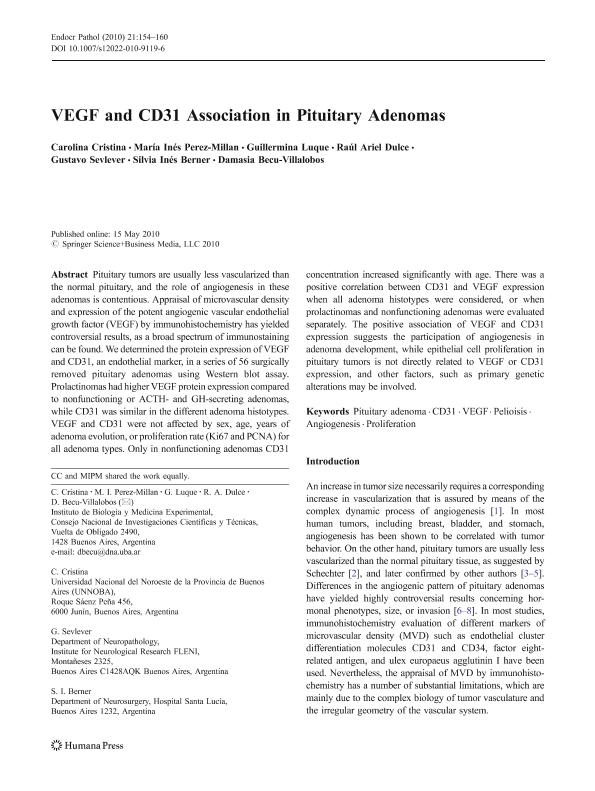Artículo
VEGF and CD31 association in pituitary adenomas
Cristina, Carolina; Pérez Millán, María Inés ; Luque, Guillermina Maria
; Luque, Guillermina Maria ; Dulce, Raul
; Dulce, Raul ; Sevlever, Gustavo; Berner, Silvia Inés; Becu, Damasia
; Sevlever, Gustavo; Berner, Silvia Inés; Becu, Damasia
 ; Luque, Guillermina Maria
; Luque, Guillermina Maria ; Dulce, Raul
; Dulce, Raul ; Sevlever, Gustavo; Berner, Silvia Inés; Becu, Damasia
; Sevlever, Gustavo; Berner, Silvia Inés; Becu, Damasia
Fecha de publicación:
09/2010
Editorial:
Humana Press
Revista:
Endocrine Pathology
ISSN:
1046-3976
Idioma:
Inglés
Tipo de recurso:
Artículo publicado
Clasificación temática:
Resumen
Pituitary tumors are usually less vascularized than the normal pituitary, and the role of angiogenesis in these adenomas is contentious. Appraisal of microvascular density and expression of the potent angiogenic vascular endothelial growth factor (VEGF) by immunohistochemistry has yielded controversial results, as a broad spectrum of immunostaining can be found. We determined the protein expression of VEGF and CD31, an endothelial marker, in a series of 56 surgically removed pituitary adenomas using Western blot assay. Prolactinomas had higher VEGF protein expression compared to nonfunctioning or ACTH- and GH-secreting adenomas, while CD31 was similar in the different adenoma histotypes. VEGF and CD31 were not affected by sex, age, years of adenoma evolution, or proliferation rate (Ki67 and PCNA) for all adenoma types. Only in nonfunctioning adenomas CD31 concentration increased significantly with age. There was a positive correlation between CD31 and VEGF expression when all adenoma histotypes were considered, or when prolactinomas and nonfunctioning adenomas were evaluated separately. The positive association of VEGF and CD31 expression suggests the participation of angiogenesis in adenoma development, while epithelial cell proliferation in pituitary tumors is not directly related to VEGF or CD31 expression, and other factors, such as primary genetic alterations may be involved. © 2010 Springer Science+Business Media, LLC.
Palabras clave:
Angiogenesis
,
Cd31
,
Pelioisis
,
Pituitary Adenoma
,
Proliferation
,
Vegf
Archivos asociados
Licencia
Identificadores
Colecciones
Articulos(IBYME)
Articulos de INST.DE BIOLOGIA Y MEDICINA EXPERIMENTAL (I)
Articulos de INST.DE BIOLOGIA Y MEDICINA EXPERIMENTAL (I)
Citación
Cristina, Carolina; Pérez Millán, María Inés; Luque, Guillermina Maria; Dulce, Raul; Sevlever, Gustavo; et al.; VEGF and CD31 association in pituitary adenomas; Humana Press; Endocrine Pathology; 21; 3; 9-2010; 154-160
Compartir
Altmétricas



